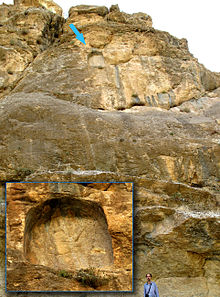The Inscription of Sargon II at Tang-i Var is carved on the flanks of the Zinanah Mt. in the Tang-i Var pass in Hawraman, Iranian Kurdistan, about 50 km southwest of Sanandaj. It was discovered during an archaeological survey carried out by Sardaraz in 1968.

It is located in a niche cut into the cliff face about 40 m above the valley floor and depicts an Assyrian ruler in a standard pose. A badly worn cuneiform inscription runs across the relief. The inscription records a campaign to the land of Karalla (lines 37 44) and also refers to Sargon's defeat of the Babylonian ruler Marduk-apla iddina 11 (Merodach -Baladan) which occurred in 710 -709. Since the Assyrian Chronicle mentions Karalla in its entry for 706, it is likely that there was a campaign to Karalla in that year, and that the relief and inscription of Sargon at Tang-i Var were made during or shortly after that campaign. This is the only known account of the campaign in Sargon's sixteenth year, a campaign that was not led by the Assyrian king.

| Neo-Assyrian Empire articles | |||
|---|---|---|---|
| Politics | |||
| Economy |
| ||
| Culture | |||
| Sargonid dynasty | |
|---|---|
| Kings | |
| Consorts | |
| Others | |
References
- Frame, G. (1999). The inscription of Sargon II at Tang-i Var. Orientalia, 68(1), 31-57.
- Kahn, D. E. (2001). The Inscription of Sargon ii at Tang-i Var and the Chronology of Dynasty 25. Orientalia, 70(1), 1-18.